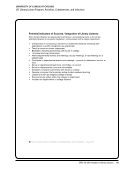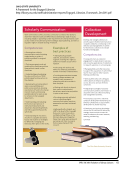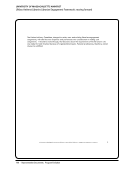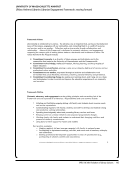188 · Representative Documents: Program Evolution
UNIVERSITY OF KANSAS
Organizational Review Team Report |Organizational Recommendations |Research and Learning Division
KU Libraries: Organizational Review Team Report
34
User-based Approach
Currently, the functions of research support, teaching support, and learning support are all handled separately and
with little coordination amongst them within the libraries. There is a focus on library functions and workflows or
library services, rather than a more explicit focus on the user and user support. Libraries are uniquely situated
to build research and learning communities that are multidisciplinary and reach across and beyond institutional
boundaries. ORT recommends a user-based structure that echos our commitment to integrating KU Libraries into
the academic life of scholars and students--not the other way around (i.e., the traditional model whereby scholars
and students must find ways to integrate with the libraries).
The Research and Learning division (R&L) will be comprised of librarians and library staff who possess expertise
in a range of areas and topics related to resource discovery and use, teaching and learning, and research. These
faculty and staff will provide support to our major constituencies on campus in each of these areas based on
distinct user needs, skills, and experiences. These librarians will engage users and build relationships based on
both the commonalities and differences that exist among these constituencies. This support will require engaging
fundamentally in the lives of students, scholars, and citizens to improve individual productivity and further their
academic goals, as well as the mission of the university. “An engagement model is a model that seeks to enhance
scholar productivity, empower learners, and integrate libraries into the research, teaching, and learning processes”
(Williams, 2009).
Compared to our current organizational structure, the integration of instruction- and research-focused services
into one division will exemplify that research and learning are not independent and distinct activities, but two
interrelated aspects of the larger scholarly enterprise. As noted above, CDS is engaging in an increasing number
of instructional activities with faculty and students, and issues such as open access, scholarly communication, and
digital scholarship should be a part of the information literacies of undergraduates, graduates, and researchers.
Similarly, it is with increasing frequency that library and research instruction lead to questions and conversations
related to copyright, fair use, and the rapidly changing resource and information environment.
Why a user-focused, team-based structure?
A user-focused, cross-functional team-based, organizational structure presents a number of advantages.
Academic institutions distinguish among undergraduates, graduates, and faculty in nearly every respect, and these
groupings are not likely to change on the whole. There is a reason for this: each possesses distinct characteristics,
skills, and needs.
• Undergraduates: are primarily students and novice researchers
• Graduates: represent a mix of advanced students, advanced researchers/scholars, and some are also
teachers
• Faculty: are primarily teachers and expert researchers/scholars
• Community: represent a mixed group of local, state, regional, and international users with a variety of
information and research needs
ORGANIZATIONAL RECOMMENDATIONS
UNIVERSITY OF KANSAS
Organizational Review Team Report |Organizational Recommendations |Research and Learning Division
KU Libraries: Organizational Review Team Report
34
User-based Approach
Currently, the functions of research support, teaching support, and learning support are all handled separately and
with little coordination amongst them within the libraries. There is a focus on library functions and workflows or
library services, rather than a more explicit focus on the user and user support. Libraries are uniquely situated
to build research and learning communities that are multidisciplinary and reach across and beyond institutional
boundaries. ORT recommends a user-based structure that echos our commitment to integrating KU Libraries into
the academic life of scholars and students--not the other way around (i.e., the traditional model whereby scholars
and students must find ways to integrate with the libraries).
The Research and Learning division (R&L) will be comprised of librarians and library staff who possess expertise
in a range of areas and topics related to resource discovery and use, teaching and learning, and research. These
faculty and staff will provide support to our major constituencies on campus in each of these areas based on
distinct user needs, skills, and experiences. These librarians will engage users and build relationships based on
both the commonalities and differences that exist among these constituencies. This support will require engaging
fundamentally in the lives of students, scholars, and citizens to improve individual productivity and further their
academic goals, as well as the mission of the university. “An engagement model is a model that seeks to enhance
scholar productivity, empower learners, and integrate libraries into the research, teaching, and learning processes”
(Williams, 2009).
Compared to our current organizational structure, the integration of instruction- and research-focused services
into one division will exemplify that research and learning are not independent and distinct activities, but two
interrelated aspects of the larger scholarly enterprise. As noted above, CDS is engaging in an increasing number
of instructional activities with faculty and students, and issues such as open access, scholarly communication, and
digital scholarship should be a part of the information literacies of undergraduates, graduates, and researchers.
Similarly, it is with increasing frequency that library and research instruction lead to questions and conversations
related to copyright, fair use, and the rapidly changing resource and information environment.
Why a user-focused, team-based structure?
A user-focused, cross-functional team-based, organizational structure presents a number of advantages.
Academic institutions distinguish among undergraduates, graduates, and faculty in nearly every respect, and these
groupings are not likely to change on the whole. There is a reason for this: each possesses distinct characteristics,
skills, and needs.
• Undergraduates: are primarily students and novice researchers
• Graduates: represent a mix of advanced students, advanced researchers/scholars, and some are also
teachers
• Faculty: are primarily teachers and expert researchers/scholars
• Community: represent a mixed group of local, state, regional, and international users with a variety of
information and research needs
ORGANIZATIONAL RECOMMENDATIONS












































































































































































































